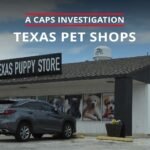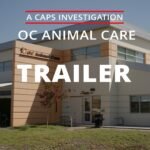Petland Largo
10289 Ulmerton Rd
Largo, FL 33771
(727) 230-1979
Date and time of CAPS investigation: 08/20/21; 1413
Approximate number of puppies and kittens observed at time of investigation: about 50 puppies and one kitten
There were about 20 enclosures for puppies (one holding a kitten) on a wall of the store. Enclosures had two to three puppies each, and were made with coated wire floorings, solid walls on three sides, and cage doors on the side that accessed a room workers used to access the puppies. Enclosures had water bottles, a blanket in each that didn’t cover most of the flooring, and dog toys. No breeder information was posted anywhere within sight of the enclosures.
I asked an employee (olive-skinned male, about 25 years old, 5’6″, 170 lbs., with short curly black hair, who did not identify himself) about puppies’ breeders. “I was wondering, do you know anything about like where they come from? I’m trying to make sure they’re not puppy mills.” He immediately responded with, “Yeah, so which one are you interested in?” I then reminded him I wasn’t trying to buy a puppy at that moment but was instead trying to determine what the puppies’ breeders are like. He then told me, “The puppies, they come from the top two percent of breeders, so it’s going to vary between the dogs.” I asked, “The top two percent?” He responded, “Specifically, for whichever dog you’re interested in.”
I then asked if he knew about specific conditions of breeders’ kennels, and if they are licensed. He responded, “Yeah, so they’re all coming from the top two percent of USDA licensed and inspected breeders. But all the breeders are licensed and inspected, and from the top two percent.” He then showed me a video on an ipad of dogs and puppies playing in yards, and kennels with massive runs, and said, “So this is what it actually looks like. They all have heated floors in their kennels, access to outdoor areas at all times. And right now, this is showing the breeders. But yeah, it’s going to vary between the dogs specifically, and this one’s from Bloomfield, Iowa, I believe.” I asked if all kennels are like I was being shown in the video, and he responded, “They’re all going to be up to the top two percent UDSA health standards.” I then asked him, “Do you know what that means? The top two percent?” He said, “The health standards.” I said, “The health standards, and he responded, “The top two percent in the US. As far as breeders go. USDA licensed and inspected.”
Then, another employee (Caucasian female, about 25 years old, 5’5″, 110 lbs., with long brown hair, who identified as Fairyana) “Yeah the USDA only has certain high standards. We actually go above those high standards. All of our breeders have to sign a contract with them {Petland} saying they’re going to go above and beyond, because our parents’ health is our biggest priority. So, there’s a lot that we do put into it. Our owner actually helps rebuild their facilities to make them what he wants them to be.” I asked her how the dogs are housed at kennels, and she said, “They’re in little kennels, but they always have access to a turnout yard.” She then showed me pictures on the iPad of dogs in large, grassy yards, and at one point noted, “So that’s also gonna’ be where they’re in when the mothers give birth, just because they have insulated floors to keep them warm, like you can see here.” I asked, “They all have that? They all have like insulated…” and before I could finish the question, she answered, “Yeah.” I then asked how often and long dogs are bred for, and she said, “So, a bigger breed is gonna’ be bred, probably two or three times in their lifetime. They don’t breed until they’re two years old and they only breed once a year. They only have one litter. But like a smaller breed, like a little Yorkie, may only breed once or twice. And our Frenchies, English Bulldogs, are gonna’ be bred once in their lifetime.”
I asked her if there’s a limit on how many dogs breeders can have, and she told me, “…typically our breeders specialize in two or three breeds. But they do have a limit on how many.” She added, “There’s gonna’ be a good amount of dogs, but they have acres of land, and they have pretty decent-sized kennels. You can look them up on Google Maps and you can see how big they actual kennels are.”
I asked if breeders have any violations, and she responded, “So I will be honest with you, if you look up stuff from some of them, there’s stuff from like, now almost six years ago. Just because that’s before our owner really took over. Just because the USDA wasn’t really that strict, they still really aren’t as strict as they should be. But especially back then, but a lot of, like Cloveridge Kennel, our owner went in to help renovate it to make them like he wants. Because he wants to make a difference in the puppy world. He’s planning on expanding this, because he does want to make a difference. He even breeds himself.” She then repeated her claim that all of the store’s breeders have turn-out yards at their kennels. Finally, she told me, “When our parents are done breeding, we actually adopt them out through our store. So, we have like momma poodles, mommy Yorkies, momma Shibas. We’ve had a few across all the stores.”
I asked the female employee for paperwork on a Pomeranian puppy, and she hand-wrote information for me to look at, showing the weight of the puppy’s parents, that the breeder is David Lee from Cincinnati, IA, and that the puppy cost $7,600. She did not note any USDA number for the breeder.
Evidence of false statements and misrepresentations of breeders by store
The employee’s claim that the USDA has a “top two percent” of breeders for health standards is false, as the USDA has no ranking system of health standards or any kind of list to rank their breeders by any method, including percentage.
The employee’s following claims are false: Larger breed dogs are bred probably two or three times in their lifetimes, don’t get bred until they are two years old, are only breed once a year and have one litter. Smaller breeders, such as a Yorkshire Terriers may only breed once or twice. And our Frenchies [French Bulldogs], English Bulldogs, are only bred once in their lifetime.” CAPS has investigated more than 1,000 puppy and kitten mills, most of them USDA-licensed. In my 18 years with CAPS, I have been to more than 800 of these facilities. To maximize profits, commercial breeders breed female dogs on every heat, which is usually two times a year (some dogs skip a cycle). Mother dogs are usually bred on their first heat. Breeders typically kill mother dogs who are no longer fertile or producing small litters. Some puppy mills do give unwanted breeding stock to rescue organizations. CAPS has rescued some of these dogs during investigations.
French and English Bulldogs are artificially inseminated and require C-sections.
https://www.ranker.com/list/bulldog-breeding-problems/mariel-loveland
The employee’s claim that the store’s breeders typically specialize in two or three breeds is mostly false. Based on CAPS investigations, USDA-licensed breeders typically have myriad breeds because of the demands of brokers and the pet shop industry.
The employee stated that if you look up stuff from some of them, there’s stuff from like, now almost six years ago. She added that that was before our owner really took over and that was when USDA wasn’t really that strict. In response to regulatory ordinances, USDA started using teachable moments, self-inspections and a trial announced inspection program. Their recent guidelines also instructed inspectors not to cite ear, eye and dental diseases as veterinary care violations (this requirement was recently changed back). It is for these reasons that USDA Animal Welfare Act violations have significantly decreased.
The claim that “when our parents are done breeding, we actually adopt them out through our store. So, we have like momma poodles, mommy Yorkies, momma Shibas is probably not true, and in fact, the employee modifies the statement by stating “we’ve had a few across all the stores.” CAPS and local activists have investigated the Petland Florida franchises and have not seen adult breeding dogs available for adoption. She refers to the mother dogs as “our parents” as if Petland Florida owns the facilities. The puppy mills belong to USDA licensed “A” breeders and unlicensed breeders who sell puppies to Blue Ribbon Puppies.
Breeder information obtained during store investigation
David Lee, Cincinnati, IA, 42-A-1586, 76 adults and 32 puppies at 12/7/20 USDA inspection
Cloveridge Kennel, Marvin and Rosemary Mullet, Corydon, IA, 42-A-1515, 75 adults and 51 puppies at 2/11/21 USDA inspection,
The numbers of adult breeding dogs and puppies at the two above facilities are consistent with being commercial breeding establishments that mass produce dogs for resale to pet shops – puppy mills.
Summary of legal cases defining “puppy mill”
Broker information obtained from June – September 2021 Certificates of Veterinary Inspection
Blue Ribbon Puppies (Levi Graber), Odon, IN, 32-B-0233, 108 puppies and three kittens at 5/5/21 USDA inspection
Graber brokers puppies and kittens from many breeders, most of whom are Amish and Mennonite. He does not breed. His 5//5/21 USDA inspection report listed 108 puppies and three kittens. His 8/38/19 inspection report listed 308 puppies.
From a report by ASPCA, which obtained CVIs from August 2019 – December 2020:
Blue Ribbon Puppies in Indiana is the single largest supplier to Florida pet stores. The Centers for Disease Control (CDC) linked Blue Ribbon Puppies as one of the puppy brokers in a multi-state, multi-drug resistant Campylobacter disease outbreak caused by contact with puppies sold at pet stores. According to the CDC’s investigation, Florida had the second highest number of Campylobacter infections nationally. Blue Ribbon Puppies was a major supplier of Petland stores in Florida, shipping to locations in Largo, Plantation, Pembroke Pines, Davie, Naples, Kendall, Fort Walton, Orlando, and Pensacola.
The owner of Petland Largo also has franchises in Plantation, Pembroke Pines, Davie, Naples, Kendall, and Doral (opened in September 2021).
https://www.cdc.gov/campylobacter/outbreaks/puppies-12-19/index.html
CAPS investigated breeders selling to Levi Graber for a November 2007 two-part story with WTHR, the NBC Indianapolis affiliate. Every one of these breeders had a puppy mill. Three of them did not have a USDA license, although they had more than four breeding females (requirement is now five).
https://caps-web.org/indianas-puppy-pipeline-wthr-com/
“Indiana’s Puppy Pipeline,” Parts 1 and 2, WTHR Indianapolis (NBC)
Unlicensed breeders who were selling to Graber (video was shot in VHS and couldn’t be transferred so is unavailable):
https://caps-web.org/graber-vera-and-abe/
https://caps-web.org/raber-ken/
https://caps-web.org/wagler-delilah-jean/
The following breeders were selling to Blue Ribbon. CAPS obtained their names from cage cards at New York pet shops, which listed Blue Ribbon as the broker.
https://caps-web.org/graber-darrell/
Darrell Graber discusses how he uses Levi Graber as his broker and discusses the breeding industry, including how older breeding dogs have no teeth left. He referred the CAPS investigator to Levi Graber, who was texting his breeders the entire time to see if they knew anything about the investigator.
https://caps-web.org/stoltzfus-john-sunny-hollow-kennel/
John Stolzfus investigation report and video
https://caps-web.org/justin-knepp/
Justin Knepp investigation report and video
https://caps-web.org/miller-wayne-karen/
Wayne and Karen Miller investigation report and video
https://caps-web.org/wagler-richard/’
Richard Wagler investigation report and video
https://caps-web.org/steven-yoder/
Steven Yoder investigation report and video
CAPS has investigated hundreds of Amish and Mennonite dog (and one cat) breeders in Pennsylvania, Ohio, Minnesota, Iowa, Missouri, Kansas, and Illinois. Most of these facilities had substandard, inhumane conditions. In addition to the story with WTHR in Indianapolis, CAPS worked on news stories with The Philadelphia Inquirer and “20/20” about Amish breeders and brokers. In general, the Amish view dogs and horses as livestock, not as companion animals. In fact, one Amish breeder stated in The Philadelphia Inquirer story that English people (how Amish refer to those outside the Amish community) don’t understand that dogs are merely livestock. He failed to understand why the English got so upset when dogs died.
ABC Tampa’s story on 8/27/20 about customers who incurred thousands of dollars of veterinary bills treating sick puppies purchased at Petland Largo
Lack of USDA violations
The fact that few breeders and brokers have USDA violations does not mean that none exist. During our undercover investigation of USDA-licensed facilities, we document violations. USDA has made it very easy for licenses not to have violations. In response to regulatory ordinances, USDA started using teachable moments, self-inspections and a trial announced inspection program. Their recent guidelines also instructed inspectors not to cite ear, eye and dental diseases as veterinary care violations (this requirement was recently changed back). It is for these reasons that USDA Animal Welfare Act violations have significantly decreased.




